Gabor滤波器:Gabor Filters
2015-12-29 12:58
555 查看
Gabor filters are bandpass filters which are used in image processing for feature extraction, texture analysis [1] ,
and stereo disparity estimation [9,10,13-15,24,30].
The impulse response of these filters is created by multiplying an Gaussian envelope function with a complex oscillation. Gabor [11] showed
that these elementary functions minimize the space (time)-uncertainty product. By extending these functions to two dimensions it is possible to create filters which are selective for orientation [7] .
Under certain conditions the phase of the response of Gabor filters is approximately linear. This property is exploited by stereo approaches which use the phase-difference of the left and right filter responses to estimate the disparity in the stereo images [9,10,13-15,24,30].
It was shown by several researchers that the profile of simple-cell receptive fields in the mammalian cortex can by discribed by oriented two-dimensional Gabor functions [2,3,6,8,16-20,22,23,25-29].
Let x=[x1 x2]T be the image coordinates. The impulse response of a Gabor filter g(x) is then given
by:

Here, the matix A determines the bandwidth and the orientation selectivity of the filter.

If the modulation frequency vektor k0 is in the same
direction as one of the envelopes axes, with

then the real part and the imaginary part of the filter's impulse response are looking as follows:
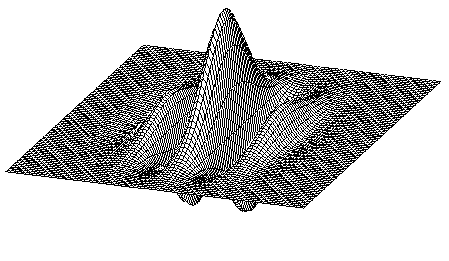
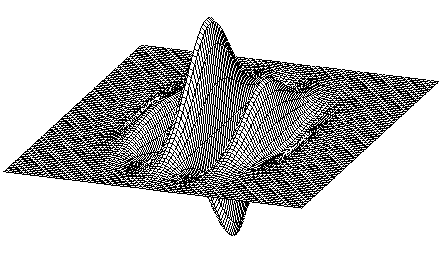
Real part and imaginary part of the impulse response of a Gabor filter
The transfer function G(k) of a Gabor filter (Fourier transform of the impulse response) is given by:

where k = [k1 k2]T is
the spatial frequency. In oder to establish a multi-resolution strategy the image can be filtered with a set of N Gabor filters with different
bandwidths and modulation frequencies. If the modulation frequencies are given by

and the relative bandwidth is choosen to be constant for all filters the image is decomposed into octaves.
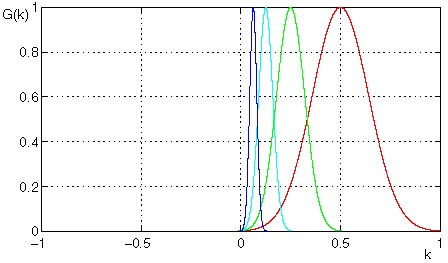
Magnitude of a Gabor filter set for N=4 in direction of the modulation frequency
In the figure shown above the transfer functions of the filters are choosen to overlap at a value of 0.5. Under this condition the DC component in the images and the frequency components lying above the frequency
twice as large as the modulation freqency are damped by at least -54dB. Thus the filter results can be sub-sampled by a factor

with neglectable aliasing effects. Furthermore the images can be decomposed into M channels of
different orientations by using filters tuned to different angles:

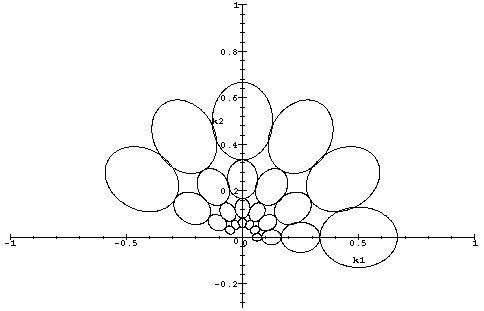
Half-value plot of the Gabor filters in the frequency plane tuned to different frequencies and orientations (30 degree resolution)
The responses of the filters lying in the lower frequency half-plane need not to be calculated explicitely, because they can be generated by the complex-conjugation of the filter response lying on the other
side of the origin. The following images show the original Lenna picture and Gabor filter results for different sampling factors. The size of the input image is choosen such that the filter results have always the same size after subsampling. This strategy
leads to a multy resolution architecture which is also called Gabor pyramid. In the best resolution channel it is possible to extract fine image structures of a small image region whereas in the lower resolution levels coarse image structures can be extracted
over large regions. This can be exploited in coarse-to-fine strategies [4,5]. On the left side of the following pictures the original input (sub)
images and the superposed filter results for all orientations are shown. On the right side the subsampled filter result is shown for each orientation.
s = 4
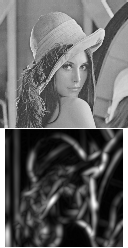
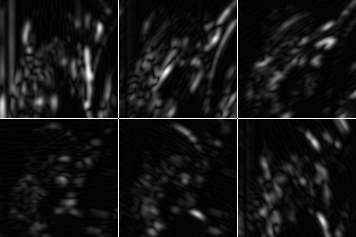
s = 2

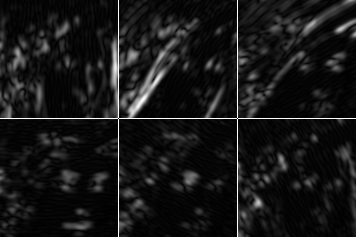
s = 1
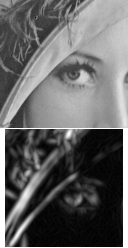
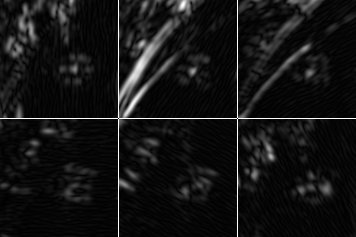
Subimages of the Lenna-picture and magnitudes of the corresponding filter results
We use a set of Gabor filters as a preprocessing step for estimation of stereo disparity and extraction
of oriented image features in the DEMONproject
from: http://homepages.inf.ed.ac.uk/rbf/CVonline/LOCAL_COPIES/TRAPP1/filter.html
and stereo disparity estimation [9,10,13-15,24,30].
The impulse response of these filters is created by multiplying an Gaussian envelope function with a complex oscillation. Gabor [11] showed
that these elementary functions minimize the space (time)-uncertainty product. By extending these functions to two dimensions it is possible to create filters which are selective for orientation [7] .
Under certain conditions the phase of the response of Gabor filters is approximately linear. This property is exploited by stereo approaches which use the phase-difference of the left and right filter responses to estimate the disparity in the stereo images [9,10,13-15,24,30].
It was shown by several researchers that the profile of simple-cell receptive fields in the mammalian cortex can by discribed by oriented two-dimensional Gabor functions [2,3,6,8,16-20,22,23,25-29].
Let x=[x1 x2]T be the image coordinates. The impulse response of a Gabor filter g(x) is then given
by:

Here, the matix A determines the bandwidth and the orientation selectivity of the filter.

If the modulation frequency vektor k0 is in the same
direction as one of the envelopes axes, with

then the real part and the imaginary part of the filter's impulse response are looking as follows:


Real part and imaginary part of the impulse response of a Gabor filter
The transfer function G(k) of a Gabor filter (Fourier transform of the impulse response) is given by:

where k = [k1 k2]T is
the spatial frequency. In oder to establish a multi-resolution strategy the image can be filtered with a set of N Gabor filters with different
bandwidths and modulation frequencies. If the modulation frequencies are given by

and the relative bandwidth is choosen to be constant for all filters the image is decomposed into octaves.

Magnitude of a Gabor filter set for N=4 in direction of the modulation frequency
In the figure shown above the transfer functions of the filters are choosen to overlap at a value of 0.5. Under this condition the DC component in the images and the frequency components lying above the frequency
twice as large as the modulation freqency are damped by at least -54dB. Thus the filter results can be sub-sampled by a factor

with neglectable aliasing effects. Furthermore the images can be decomposed into M channels of
different orientations by using filters tuned to different angles:


Half-value plot of the Gabor filters in the frequency plane tuned to different frequencies and orientations (30 degree resolution)
The responses of the filters lying in the lower frequency half-plane need not to be calculated explicitely, because they can be generated by the complex-conjugation of the filter response lying on the other
side of the origin. The following images show the original Lenna picture and Gabor filter results for different sampling factors. The size of the input image is choosen such that the filter results have always the same size after subsampling. This strategy
leads to a multy resolution architecture which is also called Gabor pyramid. In the best resolution channel it is possible to extract fine image structures of a small image region whereas in the lower resolution levels coarse image structures can be extracted
over large regions. This can be exploited in coarse-to-fine strategies [4,5]. On the left side of the following pictures the original input (sub)
images and the superposed filter results for all orientations are shown. On the right side the subsampled filter result is shown for each orientation.
s = 4


s = 2


s = 1


Subimages of the Lenna-picture and magnitudes of the corresponding filter results
We use a set of Gabor filters as a preprocessing step for estimation of stereo disparity and extraction
of oriented image features in the DEMONproject
from: http://homepages.inf.ed.ac.uk/rbf/CVonline/LOCAL_COPIES/TRAPP1/filter.html
相关文章推荐
- kalman filter 卡尔曼滤波的例子
- 蛇形走线的作用
- HEVC插值滤波器
- 标准Gabor滤波器的C语言实现
- 10种滤波算法ADC软件滤波方法及程序
- 数字图像处理中的邻域
- Gabor filter
- Gabor filter 实现的几种方式
- Gabor特征与cvGabor源码解读
- 博客学习日记-2014/11/18
- [数字信号处理]序言
- [数字信号处理] FIR滤波器基础
- [数字信号处理]使用窗函数设计FIR滤波器
- [数字信号处理]单位冲击响应与频响以及FIR实现代码(C语言)
- [数字信号处理]相位特性解卷绕
- [数字信号处理]IIR滤波器基础
- [数字信号处理]IIR滤波器的间接设计(C代码)
- [数字信号处理]IIR滤波器的直接设计(C代码)
- CVPR读书笔记[5]:Gabor特征提取之Gabor核的实现
- CVPR读书笔记[6]:Gabor特征提取
